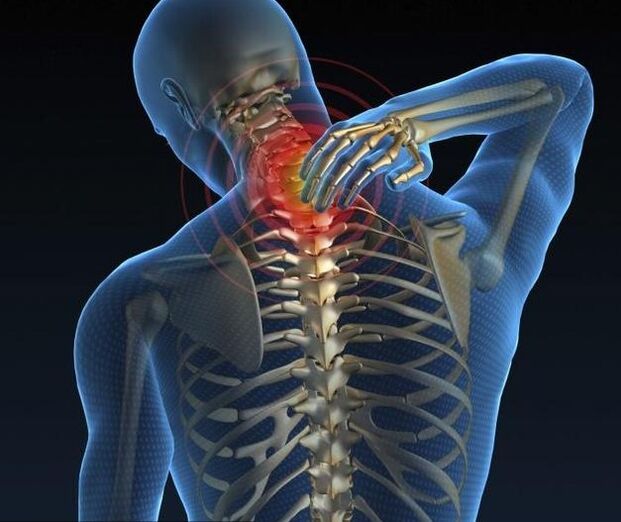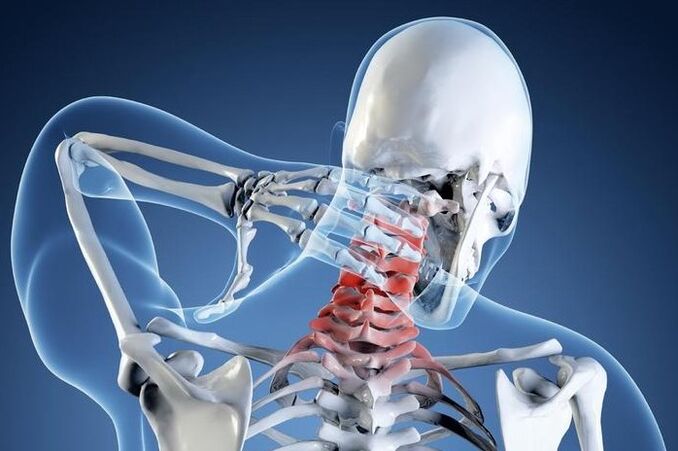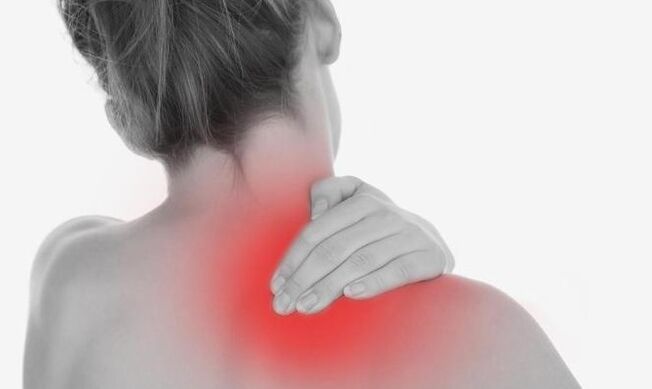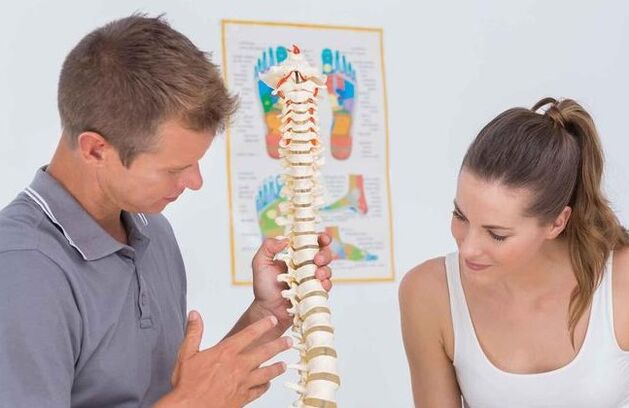About 30 years ago, osteochondrosis was associated exclusively with people -people of advanced age, whose joints became inactive and ill with every movement. However, time has changed. Today, more and more people are changing hard physical workers for jobs that are inactive on computers, they are less monitoring of food quality, and more dealing with cervical hotel osteochondrosis. No wonder osteochondrosis is called the "century disease", and almost everyone who has reached the age of 25 discovers the symptoms of the disease.

This is a dangerous disease, starting with unpleasant pain in the neck, quickly leading to severe consequences in the form of hearing and weak vision, as well as worsening memory until it is completely gone. That is why everyone should be aware of the cause of osteochondrosis and consult with a doctor in the event of a symptom of unpleasant disease. We will discuss it in this article.
The cause of the cervical area osteochondrosis
Paradoxically, all of our problems with the cervical spine begin at the beginning of children, or vice versa in primary school, where children decline posture and scoliosis develops. Currently the system keeps the spinal head violated, in particular, the most delicate and exposed department - cervix. The second major factor in osteochondrosis in the cervical region, taking its beginning in the long children's age, is inadequate physical preparation, in particular, spinal muscle weakness and muscle corset designed to support the spine.
These are two of the most important reasons for the disease. All the rest of the heavy load falls on the weak spine, which causes the development of the disease in a relatively young and healthy person. First of all, they include inactive lifestyle and lack of physical activity, in particular work, which is associated with long accommodation in one position. These are features of driver and office workers, replacing computers. All of this is supplemented by excess weight, which seriously increases the burden on the spine.
Other causes of cervical spinal osteochondrosis, it should be distinguished:
- spinal injury sent;
- metabolic violations;
- descent tendency;
- Great physical hard work;
- constant tension and nerve pressure;
- anomalies in the development of cervical spine;
- Bad habits (holding a phone tube with ear and shoulder).
The process of development of osteochondrosis
The bad factors listed eventually lead to increased load on the cervical spine. When trying to balance excessive loading of the neck muscles, their cramps occur, leading to a violation of blood circulation in this area and decreasing the metabolic process. All of this turns into the development of the degenerative process in the spine. First of all, the vertebrae begins to become thinner and closer, squeezing their contents (fibrous rings) outside the spine. Such a highlight in the language of the doctor is called protrusion.

In terms of highlights, the fibrous ring still maintains its integration, but the highlights are already squeezing the blood vessels and nerves that go beyond the spinal column and feed the brain. Moreover, the concentration and deformation of the vertebra began to squeeze the peripheral nerve root, leading to the development of "radical syndrome" that was caused by severe pain in the back and neck. If you do not identify the problem (which is unpleasant symptoms will give you a fluent signal) and do not start treating osteochondrosis, fibrous rings will break and vertebral hernia will appear. In this case, serious problems with brain nutrition arise.
Symptoms of cervical osteochondrosis
In its development, the disease goes through several stages, each with characteristic and symptom symptoms. Keep in mind that cervical spinal osteochondrosis is different from degenerative changes in other parts of the spine. The distance between the vertebraes here is minimal, and therefore, small degenerative changes cause unpleasant symptoms and lead to various complications.
Osteochondrosis degree 1.This is a premature stage of the development of the disease, in which the patient suffers a slight pain and discomfort during the head turn, as well as rapid tension and fatigue in the neck and back with prolonged discovery in one position (often in inactive condition). At this stage, osteochondrosis is properly treated with lifestyle changes, nutritional correction and normal physical training.
Osteochondrosis degree ii.At this stage, instability occurs between the vertebrae in the neck. In this case, a person is facing intense pain, which is given to the shoulder, neck or hands. During the tendency or turn of the head, the pain increases significantly, due to the decrease in the distance between the vertebrae, the nerve endings begin to break. Patients start to get tired quickly, their performance is reduced, disruption, fatigue appears, and headaches.
Osteochondrosis III.With the onset of the third stage of the disease, the pain in the back and neck becomes stronger, the mobility of the neck decreases significantly, and as the neck turns, the collapse of the vertebra can be heard. At night, the patient begins to numb with his fingers (especially small fingers and ring fingers), which is why someone wakes up several times at night. Throughout the day, such patients had an unpleasant severity in their hands. And also a short conversation on the phone, where one had to hold a cellphone near his ear, turning into an unpleasant tingling and numbness in his fingers. All of this shows an increase in prominence, and possibly the appearance of hernia in the cervical region.

Osteochondrosis degree IV.In the final stage of the disease, the vertebrate is destroyed, which stops performing their function and begins to be replaced by connective tissue. Patients in this situation may notice the violation of movement coordination, noise and pulse in the ear is crazy, increased headache, visual acuity and hearing loss. In some cases, numbness can be observed.
It should be said that due to the transfer of blood vessels, blood flow to the brain is disrupted. Therefore, patients have neurotic disorders such as insomnia, anxiety, irritation and hatred, frequent mood changes and inability to concentrate. Outbreaks of anger or fear can occur periodically, to attack longing and depression.
In the final stages of the development of osteochondrosis, the most powerful blood vessel cramps can cause the appearance of "flies" before the eyes, a sense of instability on hard, flat, dizziness, migraine, nausea, vomiting, vomiting and frequent fainting.
Diagnosis of a disease
To identify the cause of the pathology, the patient describes the unpleasant symptoms of his or her condition. After hearing the patient, the specialist sends it to one of the following methods of research.
Radiography.Currently, this diagnostic method is considered inactive, especially in the last stage of the development of the disease.
Duplasound duplex scanning.This method is used in cases where experts involve a violation of blood flow to the artery that gives the brain to the food. This study shows the blood flow rate and determines whether there are obstacles on the road.
CT (Tomography is calculated).This method is more informative than radiography, as not only reveals the problem, but also allows you to determine the presence and size of the hernia, even with difficulty.
MRI (magnetic resonance imaging).The most informative method for diagnosis of osteochondrosis, which allows you to create bone structure, presence of hernia, and even their developmental direction.
Osteochondrosis treatment
We will immediately say that to combat serious problems such as osteochondrosis of the cervical region, you should turn to neurologists. True, if the clinic has a doctor in a vertebrologist, it is best to contact it first. You can only treat comprehensive osteochondrosis. The complex methods used include drug therapy, high cervical zone massage, exercise therapy, physiotherapy methods, and proper nutrition. Only a combination of all of these methods will help overcome the disease and normalize the well -being of the patient.
Helps severe pain

In the case of strong pain syndrome, doctors recommend taking analgesics. When the fund stops with help, you can switch to anti -nonsteroids.
In general, drug therapy includes the following funds:
- NSAIDs (Anti -Systeroid drugs are not medicines). This product relieves pain, relieves swelling and overcomes nerve root inflammation.
- Chondroprotectors. Such medicines perfectly recover damaged cartilage tissue.
- B Vitamin B. They need to improve the metabolic process in the nerve tissue.
- Musorelaxants. The effects of these drugs are intended to reduce muscle cramps.
- Preparation that improves blood rheological properties. Thanks to such a way, the flow of oxygen and nutrients to the brain and the nerve endings improved.
It should be noted here that it is possible to achieve a significant effect on the fight against osteochondrosis using ointment and tablets only if treatment with drugs is combined with other therapeutic methods. Otherwise, medicines will only have a temporary effect.
Many experts tend to treat osteochondrosis by injection to quickly affect nerve endings and save patients from possible side effects when taking tablets. However, vitamins are best taken orally, as vitamins are well absorbed by the body by taking, but injections with them can be painful.
Physiotherapy treatment method
Treatment with medicines must be combined with physiotherapy therapy methods. The most effective in the disease is considered:
- Electrophoresis (in combination with drugs). The drugs in this case penetrate the damaged vertebra under the influence of electrical current.
- Ultrasound. This method of exposure allows you to relieve inflammation, soothe pain and improve metabolic processes in the tissue.
- Magnetotherapy. This type of physiotherapy relieves swelling and relieves pain.
- Laser therapy. This is a great method for combating the process of inflammation, which also improves blood circulation.
Diet for osteochondrosis
The affected vertebra recovery also includes a special diet that normalizes the metabolic processes in the body, prevents salt deposition, nourishes and restores cartilage tissue, and also strengthens the ligaments between the vertebrates.
To achieve this goal, first of all, from the patient's diet should be excluded:
- alcoholic beverages;
- fat and fried dishes;
- Sharp and too salty dishes;
- strong soup;
- weakness and sdoba;
- strong tea and coffee;
- pickles and fireplace;
- Canned products.

The diet of patients with osteochondrosis should consist of the following foods:
- meat and low fish;
- low milk, cottage cheese and kefir;
- butter (in small quantities);
- cereals and soups from the whole cereal;
- jelly, pour fish or meat;
- Vegetables, Fruits and berries;
- juice, fruit drinks, jelly and compot.
When localizing osteochondrosis in the cervical region, it is important to adhere to the drinking regime, drink at least 1. 5 liters of water daily. If you have weight gain, then you should think about how to get rid of additional pounds that put extra load on the spine. It is advisable to switch to power 5 times a day in small portions.
At the same time, as can be seen from the list of products allowed for use, the foundation of food should be low in vegetarian soup, boiled meat, fish, seafood, vegetables and sugar -free fruits.
The estimated menu for the day will look as follows:
- Breakfast: cottage cheese, a pair of apples, sugar -free tea;
- Lunch: roasted pear, a little oatmeal;
- Lunch: Vegetarian borsch, boiled chicken with vegetable salad;
- Evening snacks: dried cookies and fruits;
- Dinner: Baked fish with vegetables and tea without sugar.
Exercise therapy for osteochondrosis
Physical education produces incredible results in the treatment of osteochondrosis, the truth is to engage in gymnastics for the cervical spine only during the recovery period. It is important here that in the massage or gymnastics process, the patient does not experience discomfort and pain.

Here are some of the most effective gymnastics exercises aimed at strengthening cervical muscles and improving blood circulation in this area.
Exercise number 1Lying on the stomach and resting your hands on the floor, slowly raising your head and trunk, until the back is straight. Hold this position for 1 minute, then return to the starting position. This element is repeated 2-3 times.
Exercise number 2Lie on your stomach and stretch your hands all over your body, lift your head slightly and start it first, try to touch the floor with your ears, and then to the left. Do 6 rounds in each direction.
Exercise number 3Sit on the floor, inspiration, slipped forward, try to get to your chin to the chest, and exhale, return to the starting position and remove your head back. Repeat the elements 10-15 times.
Exercise number 4Attach your palms to your forehead and try to put pressure on your head with effort. At the same time, submerge the neck muscles, hold your hands, prevent the head pushing. Hold the pressure for 20-30 seconds, then lower your hand and rest. Repeat the elements 2-3 times, and then repeat the training in the opposite direction, giving your hand grip behind the head.
Exercise number 5Start slowly turning your head to the right and left, trying to look behind you. Make 10 rounds on each side. Good health!














